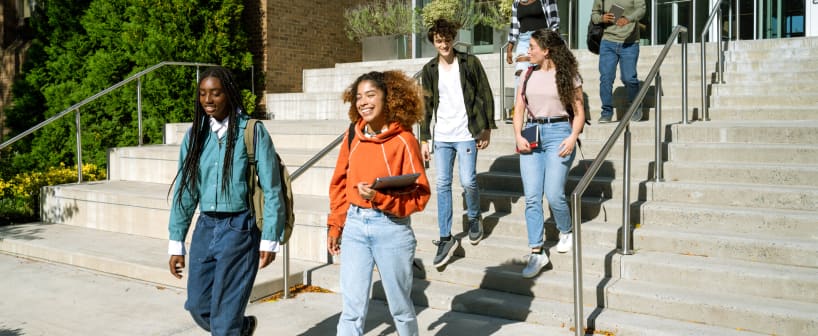By Mark J. Drozdowski
Following last summer’s Supreme Court decision banning race-conscious admissions, many pundits feared colleges, especially selective institutions, would lose momentum toward achieving racial equity.
It turns out there wasn’t much momentum to begin with.
That’s the conclusion of a new study from the Georgetown University Center on Education and the Workforce titled “Progress Interrupted.”
Does the rhetoric around diversity among elite colleges far exceed reality?
‘Marginal’ Diversity Gains Among Selective Colleges
The Georgetown study evaluated college enrollments among selective, moderately selective, and open-access institutions between 2009 and 2019, the decade before the pandemic hit and turned higher education sideways.
During that span, the “enrollment landscape at selective colleges and universities saw little fundamental change,” the report notes.
In 2019, white and Asian American/Pacific Islander students constituted 60% of the college-age population but 73% of enrollments at selective colleges. At the same time, American Indian/Alaska Native, Black/African American, and Hispanic/Latino/a students accounted for 37% of the college-age population yet only 21% of college students at selective institutions.
Students from those latter groups were more likely to be found at open-access colleges. In 2019, about two-thirds of Black/African American and Hispanic/Latino/a students and roughly 70% of American Indian/Alaska Native students attended such an institution.
A statement from the center concludes that “even with race-conscious affirmative action, diversity gains made at the nation’s most selective colleges and universities were marginal.”
But a closer look at the numbers calls into question the interpretation of “marginal.”
From 2009-2019, the percentage of Black/African American students attending selective colleges grew from 10% to 14%. And it grew among moderately selective colleges from 18% to 23%. Correspondingly, Black enrollments at open-access institutions fell from 73% to 64%.
Figures representing Hispanic and Latino/a students tell a similar story. At selective and moderately selective institutions, their numbers grew from 12% to 16%, while their numbers at open-access colleges fell from 76% to 68%.
So there’s been positive movement up the academic ladder among those two groups. Whether a 5% growth among Black students at selective colleges over a decade constitutes “marginal” gains is open to debate.
And the study concedes that the “small” increase in the “share of historically marginalized students attending selective institutions was largely driven by Hispanic/Latino students, who nearly doubled their share of the enrollment from 2009 to 2019 (emphasis added).”
It’s also true, however, that representation among white and Asian American/Pacific Islander students at selective institutions grew during that decade, from 25% to 32% and from 37% to 45%, respectively. But those gains evidently didn’t eliminate opportunities for Black and Hispanic students to do likewise.
The real story is the movement away from open-access institutions, including community colleges. Only American Indian/Alaska Native numbers remained constant, at 70%, among those institutions during the decade.
Here’s the salient message: Despite this growth, Black and Hispanic students are still underrepresented at selective colleges.
To achieve a racial balance on par with graduating high school classes nationwide, selective colleges would have to increase their numbers of Black, Hispanic, and Indigenous students by 19 percentage points, the study calculates.
The same holds true for low-income students. To achieve full representation, selective colleges would need to increase enrollments among those students by 30 percentage points.
“Not only is the American higher education system segregated by race,” the study notes, “it is also segregated by class.”
Only 20% of Pell Grant recipients, a standard proxy for low-income status, attended selective colleges, while 60% were in open-access institutions.
Now that race can no longer be considered in admissions decisions, many expect colleges to double down on targeting low-income students given the strong correlation between race and income levels. Yet such strategies already in place among states that banned affirmative action before the Supreme Court ruling haven’t necessarily generated the desired results.
Folks at Georgetown don’t believe substituting income for race will pay sufficient dividends.
“Although class-conscious admissions practices have the potential to claw back some of the diversity that will inevitably be lost,” the report posits, “they are unlikely to produce student shares that are proportional to the diversity in the total population.”
Why These Numbers Matter
Why is access to selective colleges important? Shouldn’t progress be measured by greater access to higher education, period?
Not according to the Georgetown authors, who argue that “enrollment trends matter because outcomes matter.”
Highly selective colleges are “launchpads to positions of power and influence,” they assert, with financial resources that translate into better student services and higher graduation rates.
Conversely, at open-access institutions, more than half leave college without a degree, costing them almost $1 million in career earnings on average.
“Open-access institutions educate the vast majority of college students but, unfortunately, have the fewest resources and the lowest success rates,” lead author Jeff Strohl said in the statement. “This chasm of inequity undermines the goal of the American postsecondary system to serve as an engine of opportunity for those who need it most.”
As a result, higher education is “doing exactly the opposite of what it is meant to do in a truly meritocratic society.”
In a post-affirmative action world, the study recommends, colleges must “overhaul” current admissions practices to achieve enrollments that mirror our nation’s socioeconomic diversity.
“The Supreme Court prohibition of race-conscious admissions,” it contends, “paired with selective institutions’ historically poor track record in admitting students from low-income and underrepresented racial and ethnic minority backgrounds, means that we face enormous difficulties in reversing racial/ethnic and class-based inequality, not just in higher education but in society at large.”

